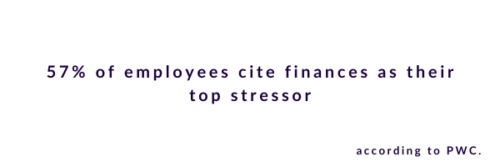Financial experts generally recommend having three to six months’ worth of expenses in an emergency fund to help cover unexpected costs. However, for many employees, putting this advice into practice is easier said than done.
In a survey of over 1,000+ U.S. adults conducted by Bankrate, 56% of respondents reported being unable to cover a $1,000 expense. Additional data from the Consumer Financial Protection Bureau found that roughly 25% of consumers have no emergency savings whatsoever.
Saving for the future is often not a priority, especially for employees living paycheck-to-paycheckHowever, having these savings is important both for individual employees and the workplace as a whole. A 2023 PwC study found that 57% of employees cited finances as their top stressor. Helping employees manage their financial stress can reduce absenteeism, improve workplace productivity and improve morale among staff members.
Here are five important ways that employers can help motivate employees to save money to help prevent financial emergencies and reach their unique financial goals.
1. Comprehensive financial wellness programs help employees save money.
While many employers offer retirement plans, financial security is not only about the distant future; it also means being prepared for unexpected expenses in the present. Addressing the broader aspects of financial wellness can lead to more immediate and impactful benefits for employees.
Educating employees on the importance of an emergency fund can help them handle any sudden costs that come their way. Many employees also struggle with debt from student loans, credit card balances and mortgages. Counseling and resources for debt reduction and management can lower financial stress and help your team regain control of their spending.
When it comes to implementing holistic financial wellness programs, employees can offer informational seminars, presentations, newsletters and free financial help resources that help boost financial literacy. Ask employees how they prefer to access such resources to maximize their usage. For example, some employees may prefer to learn from a website while others would rather talk to an expert. For employees looking for more direct guidance, providing access to a financial counselor who can work one-on-one with employees is crucial. Qualified advisors can help individuals set goals, formulate budgets, choose investments and save money.
When figuring out what content employees want and need to learn, consider what financial wellness means to them. Center your strategies around SMART goals: specific, measurable, achievable, realistic and time-limited. Make sure you also provide support for any strategies you suggest. Encourage present-oriented thinking so employees are motivated to act immediately and incorporate rewards for goal achievements. Stories, testimonials and real-life examples can inspire employees to take action and follow through with their financial plans.
2. Focus on improving your existing benefits communication.
Some employers already offer financial benefits that help their employees save money – however poor benefits communication means these services go unused. Recent data from the Bureau of Labor Statistics estimates that benefits account for just under 40% of an employee’s total costs. So, when your team fails to take advantage of their existing benefits, both the employee and employer lose money.
Benefits communication efforts can increase employee engagement, financial wellness and staff satisfaction. Furthermore, there is a demand for clearer communication among employees themselves. According to the Society for Human Resource Management (SHRM) 2023 Employee Benefits Survey, 71% of employees want more accessible information about their benefits choices. Through consistent communication with employees, employers can increase the take rate of benefit opportunities and help employees manage their savings.
3. Use default opt-out for retirement plans.
In some cases, it may also help to make benefits participation automatic. Rather than having employees opt into a company’s retirement plan, employers can automatically enroll all employees into the plan unless they actively choose not to participate by opting out. This way, workers have to take action to not be enrolled in the retirement plan and many end up taking the path of least resistance by staying enrolled, thus making regular retirement contributions.
Employers can also offer retirement plans to new and part-time employees, as long qualifying work periods can discourage workers from saving for retirement—avoiding these buffer periods can attract and retain talent.
4. Help employees save money by offering debt education.
Monthly debt payments and high interest rates eat up space in employee budgets, making it difficult to save money. However, employers can step up to help employees manage their debt and make room in their budgets to cover surprise expenses.
The process of managing debt begins with understanding employees’ needs. For example, student loan debt follows some employees far into their lives; 46% of student loan debt is held by those over 40 years old. Offering housing assistance is another way employers can help with debts among the housing shortages and increasing home and mortgage costs. This can be done through down payment offerings and closing cost assistance in the form of a loan forgivable over a designated period.
Grants, loans and security deposits, along with homeownership education and counseling, can also help employees with mortgage loan support. Debt consolidation resources can also help simplify the debt repayment process so employees can quicken their debt payoff by merging the separate payments into a single monthly payment. This may also allow employees to pay an interest rate less than the average interest rates of their multiple debts.
5. Facilitate payroll deductions and on-demand pay to help save money.
78% of Americans live paycheck to paycheck, a 6% increase from the previous year, according to a 2023 survey conducted by Payroll.org. These numbers underscore the urgent need for employers to take steps to support their employees’ ability to save money.
One way for employers to do this is by enforcing payroll deductions that allow workers to make after-tax contributions to a savings fund for emergencies or large upcoming expenses. Because the process is fully automatic, it makes saving easy for employees—the earnings go straight from the payroll to this rainy day fund so people are not tempted to use the money from the accounts for everyday costs.
On-demand pay is another way for employers to support employees financially. On-demand pay gives employees access to their pay as they earn it—employees can request a portion of their pay before the end of the pay period, which supports their short-term financial security, giving them the flexibility to cover bills and emergency expenses as they arise without sacrificing long-term financial stability, allowing them to establish a solid financial foundation.
Help your team build their savings with Best Money Moves.
Best Money Moves is a mobile-first financial wellness solution designed to help dial down employees’ most top-of-mind financial stresses. As an easy-to-use financial well-being solution, Best Money Moves offers comprehensive support toward any money-related goal. With 1:1 money coaching, budgeting tools and other resources, our AI platform is designed to help improve employee financial well-being.
Whether it be retirement planning or securing a mortgage, Best Money Moves can guide employees through the most difficult financial times and topics. We have robust benefits options for employers, regardless of their benefits budget.
Our dedicated resources, partner offerings and 1000+ article library make Best Money Moves a leading benefit in bettering employee financial wellness.
To learn more about Best Money Moves Financial Wellness Platform, let’s schedule a call. Contact us and we’ll reach out to you soon.


